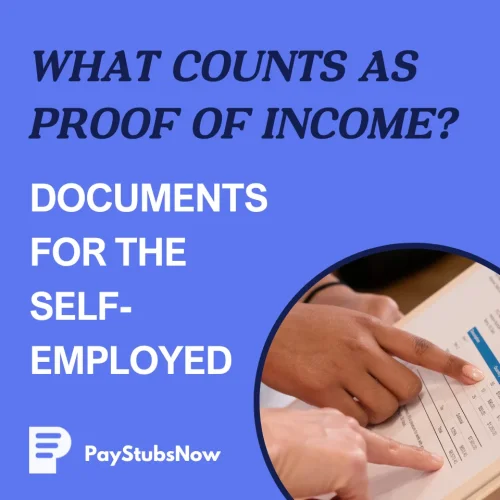


If you're self-employed, proving income takes more than a W-2. Freelancers, contractors, and business owners often need multiple documents to verify earnings. Whether you're applying for a loan, renting, or filing taxes, having clear income documentation is key.
In this guide, we'll break down exactly what qualifies as proof of income documents for self-employed individuals and how to quickly create or gather them. From tax returns and 1099s to pay stubs and profit and loss statements, you'll discover how to present consistent income records and stay ready for any verification request.

Proof of income is any official documentation that verifies your earnings over a specific period. For self-employed individuals, freelancers, and small business owners, this isn't as simple as showing a W-2 from an employer. Instead, you need to provide documents that collectively demonstrate a consistent and reliable flow of income to lenders, landlords, or other institutions.

Having proof of income is essential for many of life's biggest financial steps, and numerous social-service programs require documented earnings to calculate eligibility. Without it, eligible workers can even lose benefits. As a self-employed professional, you'll likely need to provide it when:
Understanding proof of income is just one part of managing your self-employment finances. If you want to make tax season less stressful, get step-by-step guidance on filing as an independent contractor—what forms you'll need, deadlines to watch, and how to stay compliant.

Here are 9 reliable methods for self-employed individuals to show proof of income:
Tax Returns (IRS Form 1040)
Your federal tax return is the gold standard for proving self-employment income. It provides a comprehensive, year-long view of your earnings, deductions, and net income—all verified by the IRS.
Who Requires It: Most lenders, landlords, and financial institutions prefer two years of returns to assess long-term stability.
Why It Works: Tax returns are official legal documents that confirm your reported income, making them one of the most credible forms of proof available.
Tip for Self-Employed Workers: If your net earnings are $400 or more in a year, you must file a return. Keep both digital and physical copies on hand for quick submission.
1099 Forms (1099-NEC/1099-MISC)
1099 forms document income from clients or platforms that pay you $600 or more annually. They're issued by the payer and report total payments, but they do not show taxes withheld.
Types to Know:
Why It Works: These forms offer third-party verification of your income, which adds credibility when paired with other documentation.
How Paystubsnow Helps: Our 1099 generator produces accurate, IRS-compliant forms in minutes, reducing manual work and minimizing errors.
Self-Employed Pay Stubs
Even if no one issues you a pay stub, creating your own can show consistent, regular income in a professional, lender-friendly format.
What to Include: Gross pay, estimated tax deductions (Social Security, Medicare, etc.), and net pay.
Why It Works: Pay stubs present your earnings clearly, support accurate recordkeeping, and help ensure your reported income is backed by credible documentation rather than estimates.
How Paystubsnow Helps: Our platform allows you to instantly generate accurate, compliant pay stubs that meet state-specific requirements.
W2 Forms
While W-2s are typically issued to traditional employees, some self-employed individuals receive one if a company withholds taxes on their behalf—usually after being reclassified as an employee.
When You Might Receive One: If a client changes your status from contractor to employee.
Why It Works: W-2s show total annual earnings, taxes withheld, and are widely recognized as reliable income proof.
How Paystubsnow Helps: If you need to issue a W-2 for yourself or employees, our W-2 generator makes it quick to create accurate, IRS-compliant forms.
Bank Statements
Bank statements give a clear snapshot of your income flow and business transactions.
How to Use Them: Highlight deposits related to client payments or sales revenue, and consider maintaining a dedicated business account to separate personal and business finances.
Why It Works: Statements serve as verifiable proof of deposits, especially when paired with other documents like invoices or 1099s.
Profit and Loss Statement (P&L)
A P&L statement summarizes your income and expenses over a set period, showing your business's net profit or loss.
What to Include: All income sources, itemized expenses (including cost of goods sold), and net totals.
Why It Works: Lenders and agencies value P&Ls because they provide insight into your business's financial health beyond just revenue numbers.
Pro Tip: Update your P&L regularly—quarterly or monthly—to always have a current version ready.
Invoices and Billing Records
Invoices are individual proof points for the work you've performed and payments you've earned.
What to Include: Your business details, client information, service descriptions, amounts due, and payment terms.
Why It Works: When combined with payment confirmations or bank statements, invoices create a full trail of your income.
How Paystubsnow Helps: Use our invoice generator to produce polished, detailed invoices that reflect professionalism and legitimacy.
Letter from a CPA or Accountant
A signed letter from a CPA or enrolled agent verifying your income can carry significant weight with lenders, landlords, and agencies.
What It Should Include: Your name and business entity, a statement confirming income based on your records or tax filings, and the CPA's contact details and signature.
Why It Works: This third-party validation adds credibility, especially if your other records are limited or irregular.
Business Records or Ledgers
Maintaining an organized ledger of all income and expenses ensures you have a detailed history of your earnings.
What to Include: Dates, client names, payment amounts, and expense records.
Why It Works: When paired with documents like bank statements or 1099s, ledgers provide a comprehensive financial picture that's easy to verify.
Pro Tip: Use digital bookkeeping tools to keep your records accurate, searchable, and ready to export if needed.

Demonstrating self-employment income requires more than just one form or document. Financial institutions, landlords, and government agencies often ask for multiple records to assess consistency, credibility, and cash flow.
Maintain Detailed Records
Keep accurate, organized records of all income and expenses, including invoices, receipts, bank statements, 1099s, profit and loss statements, and tax returns.
Provide Multiple Documents
Lenders and agencies typically won't accept just one proof of income. They may request a combination, such as tax returns, pay stubs, and bank statements.
Address Income Fluctuations
Inconsistent earnings are common in self-employment, particularly for seasonal or project-based work.
Use a Business Bank Account
A dedicated business bank account keeps personal and business finances separate, simplifies recordkeeping, and makes income easier to verify.
Seek Professional Advice When Needed
Accountants, bookkeepers, and other financial professionals can guide you through income verification requirements for your specific goals.
Proving income as a self-employed professional doesn't have to be complicated. By combining the right documentation strategies with the convenience of Paystubsnow, you can manage your finances confidently and stay prepared for any verification request.
With Paystubsnow, you can create trustworthy, compliant documentation in minutes, saving time, reducing stress, and ensuring you're always ready to present proof of income that lenders, landlords, and agencies will trust.